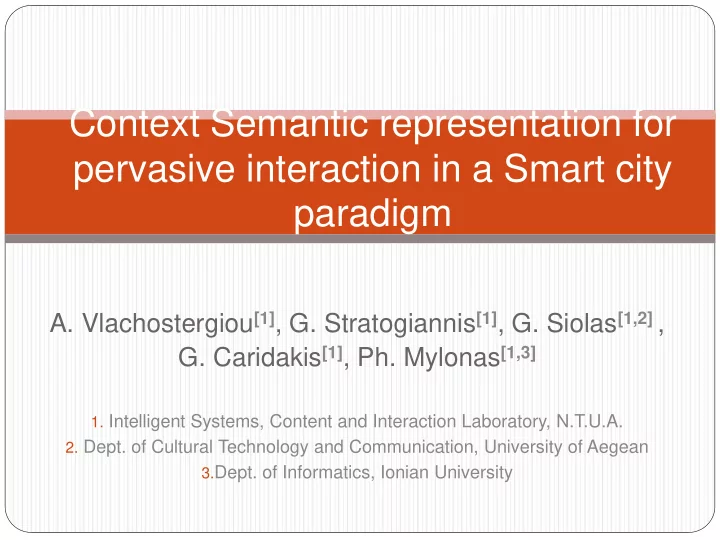

Context Semantic representation for pervasive interaction in a Smart city paradigm A. Vlachostergiou [1] , G. Stratogiannis [1] , G. Siolas [1,2] , G. Caridakis [1] , Ph. Mylonas [1,3] 1. Intelligent Systems, Content and Interaction Laboratory, N.T.U.A. 2. Dept. of Cultural Technology and Communication, University of Aegean 3. Dept. of Informatics, Ionian University
Talk Outline Motivation Context in Ubiquitous Interaction Semantic Representation Experimental Validation Conclusions - Future Work 2
Application Domains Human computer interaction Emotion Recognition Education and Multimodal interfaces Ubiquitous Interaction Smart Cities Group behavior Entertainment 3
Research Areas Ubiquitous Computing multimodal signal processing, machine learning, statistical modeling, human-centered computing Human-centered computing • Recognition and analysis of emotional expression • Modeling and fusion of multimodal affective signals General social behavior under diverse contextual settings • From emotions to general human states, e.g. frustration, engagement • Analysis of individuals, dyad and multiparty behavior within smart homes • Incorporating context into multiparty multimodal interaction Applications 4 • Personalized interfaces, smart sensing environments
What is Context? Who you are with, where you are, when, what resources Modifications of small and large are nearby 1 groups of people, changes in individual’s behavior 7,8,9 Location, identities of people, time of day, sensors , season 2 Individual and social Context-awareness context, perceived involvement 6 User’s location, identity, environment 3 Identity, Time, Location, Sensors , Identity, Time, Activity, Relations 5 Location, Activity 4 1. B. Schilit et al,1994. 2. P. J. Brown et al, 1997. 6. F. Bonin et al, 2012. 3. N. S. Ryan et al, 1998. 7. T. Choudhury and A. Pentland, 2003. 4. G. D. Abowd et al, 1999. 8. D. Gatica-Perez, 2009. 5 5. A. Zimmermann et al, 2007. 9. M. Wollmer et al, 2012.
Sensors Sensors are divided to: In house sensors: Sensors that are located in the houses, Sensors can be to different rooms (e.g. bathroom bedroom, kitchen). City sensors SmartSantander sensors are used. 6
Type of Sensors • In house sensors can be: – Temperature , – Humidity, – Luminosity , – Water and Power consumption levels, – Human presence, – Noise • City Sensors can be: – Mobility sensors, – Traffic and parking sensors, – Environmental sensors – Park and garden irrigation sensors. 7
Smart Santander Sensors 8
Semantic Representation “Home Rules” Representational approach of the home rules can be created in the ecosystem 9
Semantic Representation of the Ecosystem using Hierarchical Ontologies 10
Semantic Representation of the Ecosystem using Ontology structure 11
Semantic Representation of the Home rules in Ontologies Things are needed to trigger a home rule are: SWRLs: Restriction property: 12
Experiment “Triggering a Home Rule” Home rule: the Air-conditioner should not be switched on, when the temperature is higher than 15 ° C, the luminosity is lower than 100 lux and no human presence is detected in the house. Luminosity and Temperature levels of the SmartSantander city sensor 13
Conclusions – Future Work (1) Novel formalization to capture the semantics of Smart Home environments Experts ensure semantic interoperability Formal machine - processable representation defines, extracts and uses a set of concepts and their fuzzy semantic relations High level semantic representation language to define complex home rules 14
Conclusions – Future Work (2) Exploration of other rule based paradigms (e.g. OWL 2 RL ontology with the SPIN rule based reasoner) Incorporation of the user, usage and the context information through a unified semantic representation, for personalized services and optimization Exploration of the computational cost and the scaling of SandS to a wider user group 15
Intelligent Systems, Content and Interaction Laboratory (ISCIL), N.T.U.A Thank you ! Any Questions ? 16
Recommend
More recommend